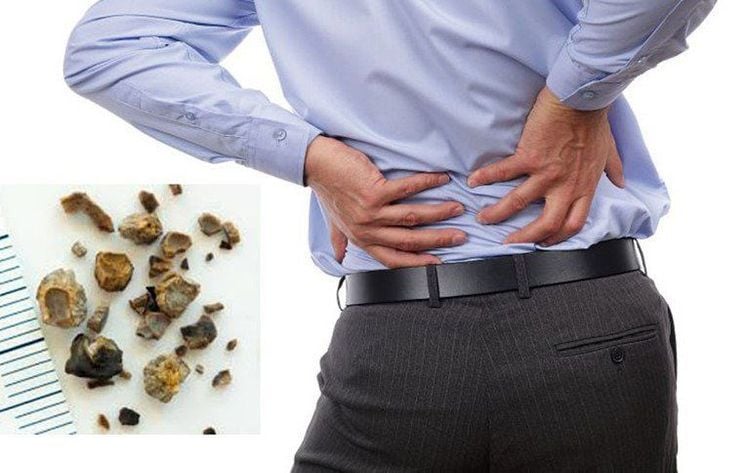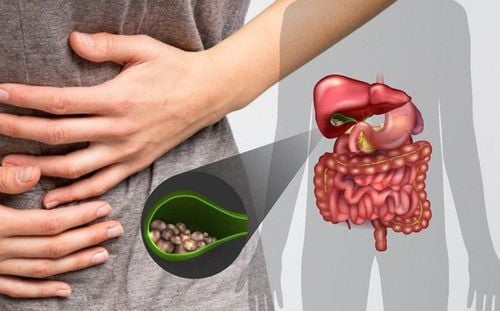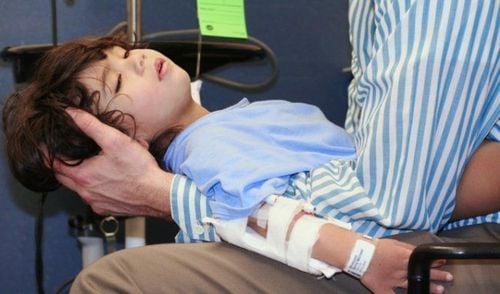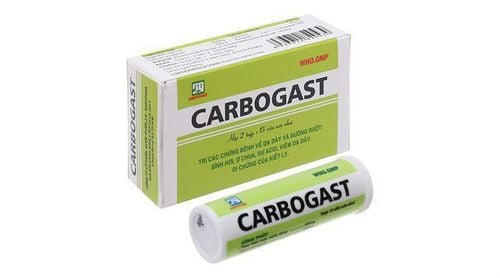This is an automatically translated article.
Extracorporeal kidney stone lithotripsy is a highly safe, non-invasive urolithiasis treatment method that shortens hospital stay and maximizes cost savings for patients.
1. What are kidney stones?
When substances normally excreted by the kidneys remain in the urinary tract, they can crystallize and harden into kidney stones. Some kidney stones are small or fine enough to pass easily through the urinary tract without discomfort. Other stones may have rough edges or grow as large as peas that cause pain as they pass or get stuck in the urinary tract. The areas most susceptible to trapping kidney stones are the bladder, ureters, and urethra.
Most kidney stones grow small enough to pass without intervention. However, in about 20% of cases, the stone is larger than 2cm (about an inch) and may require treatment. Most kidney stones are composed of calcium; however, there are other types of kidney stones that can develop. Types of kidney stones include:
Calcium stones: Calcium, a normal part of a healthy diet used in bones and muscles, is usually flushed with the rest of the urine. However, excess calcium that is not used by the body can combine with other waste products to form stones. Alluvial stones: Struvite stones, which are composed of magnesium, phosphate, and ammonia, can occur after a urinary tract infection. Uric acid stones: Uric acid stones can occur when the urine is too acidic, as in certain conditions, such as gout or melanoma. Cystine stones: Cystine stones are composed of cystine, one of the building blocks that make up muscles, nerves, and other parts of the body.

Sỏi thận thường thấy ở bàng quang, niệu đạo
2. Kidney stone lithotripsy
2.1. Extracorporeal kidney stone lithotripsy
Extracorporeal lithotripsy is a noninvasive (skin is not punctured) procedure used to treat kidney stones that are too large to pass through the urinary tract. This method treats kidney stones by sending focused ultrasound energy or shock waves directly to the stone that is first placed by fluoroscopy (a type of X-ray film, video) or ultrasound (high frequency sound waves) ). The shock wave breaks a large stone into smaller stones that will pass through the urinary system. This lithotripsy allows people with stones in their urinary system to avoid an invasive surgery to remove stones. To aim the wave, your doctor must be able to see the stone under an X-ray or ultrasound.
The introduction of lithotripsy in the early 1980s revolutionized the treatment of patients with kidney stones. Patients who have previously required major surgery to remove their stones can be treated with lithotripsy, and even without an incision. As such, lithotripsy is the only non-invasive treatment for kidney stones, which means that no incisions or surgical instruments are required.
Renal lithotripsy involves the use of a series of shock waves to the targeted stone. The shock waves, generated by a machine called a lithotripter, are focused by X-rays at the kidney stone. The shock waves enter the body, through the skin and tissue, to the stone where they break it into small pieces. For several weeks after treatment, those small pieces are passed out of the body in the urine.
2.2. Procedures and procedures for extracorporeal kidney stone lithotripsy
Your doctor will explain the procedure thoroughly to you, next you will be asked to sign a consent form to allow you to have the procedure. Read the application form carefully and ask questions if something is unclear.
In addition to a complete medical history, your doctor may perform a complete physical exam to make sure you are in good health before undergoing the procedure. You may undergo blood tests or other diagnostic tests.
Fasting before the procedure may be indicated, depending on the type of anesthetic or sedative used. You will be given instructions on how many hours to fast before the procedure if necessary. Based on your medical condition, your doctor may require other specific preparations.
Because lithotripsy is a completely non-invasive therapy, most lithotripsy treatments are done on an outpatient basis, meaning you can leave the hospital as soon as possible. End the process of kidney stone lithotripsy outside the body.
Although the use of anesthetics is independent of the requirements of the patient and the physician, recent data suggest that the outcome of nephrolithiasis may be improved with the use of a mild anesthetic.
Once the patient is fully anesthetized, a computerized X-ray machine is used to locate the stones in the kidney. A series of shock waves are introduced into the gravel. The treatment regimens combined with the latest research results show that modulating both the shock wave power and the shock wave propagation speed can affect the treatment outcome.
The goal of lithotripsy is to maximize the rupture of the patient's kidney stone while minimizing the trauma that the shock wave can cause to the kidney and surrounding organs.
Normally, the extracorporeal lithotripsy process takes about an hour. Accordingly, the lithotripsy procedure follows the following procedure:
You will be asked to remove any clothing or items. jewelry or other objects that may interfere with the process. An intravenous (IV) line will be inserted into your arm or hand. You may receive a sedative or anesthetic to make sure you remain and pain-free during the procedure. After the sedation takes effect, you will be placed on a mattress filled with water or immersed in a tub filled with water. After the stone has been positioned with fluorescence or ultrasound, it is fixed so that the wave is aimed correctly. If you are awake during the procedure, you may feel a light touch on your skin. A series of shock waves will be created to break up the kidney stone. The stones will be monitored with fluoroscopy or ultrasound during the procedure. A stent may be placed in the ureter to help the stones pass. Once the stones are small enough to pass through the urinary system, the procedure is over. After the procedure, you will be taken to the recovery room for observation. Once your blood pressure, pulse, and breathing are stable and you're awake, you'll be taken to a hospital room or discharged home.
You can continue with your usual diet and activities unless your doctor advises you otherwise. You will be encouraged to drink extra fluids to dilute your urine and ease the discomfort of passing stones. Also, you may notice blood in your urine for a few days or so after the procedure. This is normal. You may notice bruising on your back or abdomen. Patients can take pain relievers as recommended by the doctor. Aspirin or some other pain reliever can increase the risk of bleeding. Be sure to only use medications prescribed by your doctor. Notify your doctor if you experience the following abnormalities:
Fever and/or chills Persistent burning while urinating Unusual frequency of urination Extreme lower back pain
2.3. Advantages and disadvantages of kidney stone lithotripsy
The main advantage of lithotripsy is that it is completely non-invasive. Gentle treatment, little pain, short implementation time (45 - 60 minutes), fast recovery time. Less damage to the kidney: The effect of extracorporeal lithotripsy on kidney function is less than 1%, while open surgery to remove the stone can cause more than 30% loss of kidney function due to the sugar itself. Incision on renal parenchyma during treatment.
Renal lithotripsy is very suitable for patients with small kidney stones that can be easily seen with x-rays. When kidney stones become too large to pass through the urinary tract, they can cause severe pain and can also block urine flow. An infection may develop. Renal lithotripsy can be performed to treat certain types of kidney stones in certain locations in the urinary tract.
However, there are risks associated with radiation exposure that may be related to the number of X-ray examinations or treatments that accumulate over a long period of time. Complications of lithotripsy can occur as follows:
Bleeding around the kidney, infection. Urinary tract obstruction caused by fragments of stones breaking off from large stones. Remaining stone fragments may require multiple lithotripsy. Accordingly, kidney stone lithotripsy is contraindicated in the following cases:
Pregnant patient. Patients taking "blood thinners" or patients with bleeding disorders. Aspirin or other blood thinners must be discontinued for at least 1 week prior to lithotripsy treatment. The patient has a chronic kidney infection, because some debris may not pass, so the bacteria will not be completely eliminated from the kidney. The patient has a blockage or scar tissue in the ureter, which can prevent stone fragments from passing. Patients with stones that include cystine and certain types of calcium, because these stones do not fragment well with extracorporeal lithotripsy. Patients with pacemakers should inform their treating physician. Renal lithotripsy can be performed on patients with pacemakers with the approval of their cardiologist and using certain precautions. A pace-responsive pacemaker implanted in the abdomen may be damaged during lithotripsy treatment.
It is a fact that patients after performing kidney stone treatment can have a risk of kidney stone recurrence accounting for more than 20%, the cause of recurrence is still largely due to diet and activity. Therefore, to prevent recurrence of kidney stones, you should follow the following guidelines:
Minimize the amount of foods containing a lot of oxalate and calcium such as almonds, chocolate, .. limit eating low in animal protein Some medications are used to help control the amount of minerals that develop in the urine. Should not eat too many foods such as pig's intestines, animal brains... that are easy to cause stones Every day should drink from 1.5 to 2 liters of water, should increase the use of water mixed from tapioca, black bean juice, Fruit juice is cool, diuretic, helps to excrete calcium well.

Phụ nữ mang thai không được phép sử dụng phương pháp tán sỏi thận ngoài cơ thể
Above is useful information about extracorporeal kidney stone lithotripsy - one of the most advanced kidney stone treatment methods today. Hopefully through the article will help readers know more about the method of kidney stone lithotripsy? To get the right treatment for you and your loved ones if you have this disease.
Extracorporeal lithotripsy is a highly safe, minimally invasive kidney stone treatment method that shortens hospital stay and saves costs for patients. However, the results of treatment also depend on many factors such as the health and performance of the doctors as well as the equipment and machinery used to create the Hospital. Therefore, choosing a hospital to treat stone disease is very important.
Currently, Vinmec International General Hospital is a prestigious address for treating urolithiasis by extracorporeal lithotripsy, which is examined and treated by many patients. With a team of highly qualified and experienced doctors and a system of modern equipment, the best support for extracorporeal lithotripsy is less recurrence.
If you need advice on extracorporeal lithotripsy treatments at Vinmec International Hospital, please contact HERE.
SEE ALSO:
How does pain from urinary stones happen? Are there ways to treat kidney stones larger than 10mm? How to detect urinary stones?













